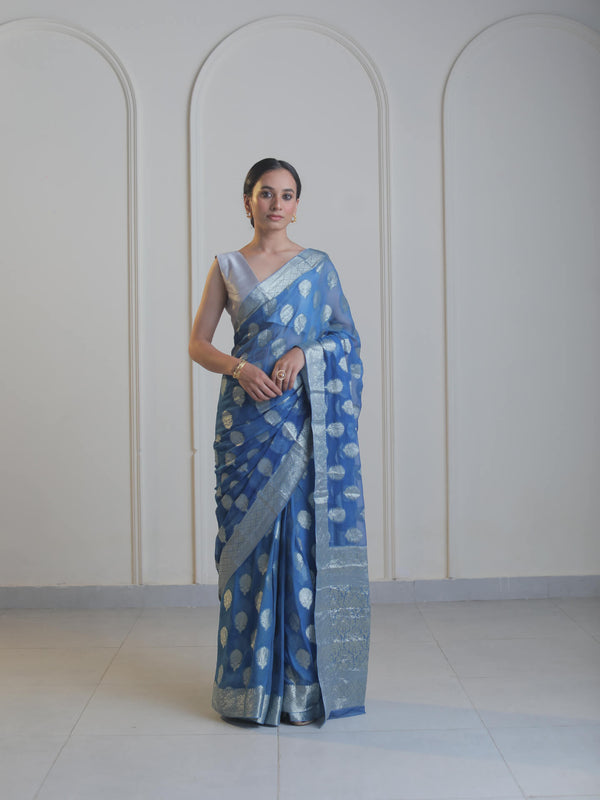
Weaving Stories: A Comprehensive Journey Through Saree Fabric Varieties
Have you ever wondered how a single drape can tell a thousand stories? From the whisper of silk to the rustle of cotton, each types of saree fabric sings a unique song, woven with threads of tradition, artistry, and sheer magic. So, embark with us on a vibrant journey through the kaleidoscope of saree materials, where we'll untangle the secrets of Banarasi's brocade, the whisper of Kanjivaram's silk, and the earthy charm of Tussar's embrace.
Let's discover the best saree fabric for every occasion, every mood, and every woman, proving that the drape is more than just cloth; it's a tapestry of stories waiting to be unravelled. Get ready to weave your own narrative with every fold, every rustle, and every exquisite touch – welcome to the world of different types of saree fabrics!
Evolution Of Types Of Saree Fabric: A Drape Through Times
The saree, much like India itself, boasts a rich and vibrant history interwoven with tales of innovation, influence, and unwavering cultural significance. Its fabric journey, stretching back millennia, is a testament to the craftsmanship and artistry that continues to captivate us today.
-
Ancient Beginnings: Our earliest glimpses come from the Indus Valley Civilization, where draped garments crafted from cotton and silk hint at the saree's nascent form. These simple weaves, adorned with natural dye motifs, showcased practicality and an evolving sense of aesthetics.
-
Mughal Majesty: From the 16th century onwards, the Mughal era ushered in an era of opulence. Saree materials like silk and muslin took centre stage, embellished with gold threads, zardozi embroidery, and intricate zari work. Brocades from Benaras and velvets from Kashmir became emblems of royalty, transforming the saree into a canvas of unparalleled grandeur.
-
Post-Independence Renaissance: With independence, the saree became a symbol of national pride. Traditional weaves re-emerged, while designers experimented with contemporary cuts and motifs. Fabrics like Tussar silk and Kalamkari gained prominence, reflecting a renewed appreciation for India's diverse textile heritage.
Understanding The Different Types Of Saree Fabric
Now that we've journeyed through the historical tapestry of saree fabric types, let's get down to the practical stuff! Understanding the basic types of saree fabrics empowers you to make informed choices, appreciate the craftsmanship, and truly own your drape.
Silk Sarees
Silk is the most luxurious and elegant of all saree material types. It is made from the cocoons of silkworms, and its smooth texture, shimmering sheen, and rich drape make it a timeless classic. Silk sarees are perfect for special occasions, and they come in a wide range of colours, patterns, and weaves.
Some of the most popular types of silk sarees include
1. Kanjivaram
These sarees are made from fine, hand-loomed silk and are known for their intricate patterns and motifs. Kanjeevarams are often embroidered with gold or silver thread, and they are considered to be one of the most prestigious types of silk sarees in India.

2. Banarasi
These sarees are also made from hand-loomed silk, but they are known for their bold, intricate brocade patterns. Banarasis are often made with gold or silver thread, and they are a popular choice for weddings and other formal occasions.
3. Tussar
These sarees are made from the silk of the Tussar moth, which is found in India and Nepal. Tussar silk is known for its earthy, natural colour and its soft, supple texture. Tussar sarees are often made with simple, understated patterns, and they are a popular choice for everyday wear.
Cotton Sarees
Cotton is the most versatile of all saree material types. It is comfortable, breathable, and easy to care for, making it a great choice for everyday wear. Cotton sarees come in a wide range of colours, patterns, and weaves, and they can be dressed up or down depending on the occasion.
Some of the most popular types of cotton sarees include
1. Chanderi
These sarees are made from fine, hand-loomed cotton and are known for their delicate, sheer texture. Chanderi sarees are often embroidered with intricate patterns, and they are a popular choice for formal occasions.
2. Khadi
These sarees are made from hand-spun and hand-woven cotton. Khadi is a sustainable fabric that is known for its natural, earthy look. Khadi sarees are a popular choice for everyday wear, and they are often associated with India's independence movement.
3. Gadwal
These sarees are made from fine, hand-loomed cotton and are known for their intricate, geometric patterns. Gadwal sarees are often made with a warp and weft of different colours, which creates a striking visual effect.
Synthetic Sarees
Synthetic sarees are made from man-made fibres such as polyester or nylon. These saree fabric types are often less expensive than silk or cotton sarees, and they are easy to care for. Synthetic sarees come in a wide range of colours, patterns, and weaves, and they can be dressed up or down depending on the occasion.
Some of the most popular types of synthetic sarees include:
1. Georgette
These sarees are made from a lightweight, sheer fabric that is often used for formal occasions. Georgette sarees are often embroidered with intricate patterns, and they can be made from a variety of colours and materials.

2. Chiffon
These sarees are made from a lightweight, flowing fabric that is often used for everyday wear. Chiffon sarees are often made in solid colours, but they can also be found in a variety of patterns and prints.

3. Crepe
These sarees are made from a textured fabric that is often used for formal occasions. Crepe sarees can be made from a variety of colours and materials, and they are often embellished with intricate patterns.
Ultimately, the best saree fabric for you depends on your personal preferences and needs. If you are looking for a luxurious and elegant fabric for special occasions, silk is a great choice. If you are looking for a comfortable and versatile fabric for everyday wear, cotton is a good option. And if you are looking for an affordable and easy-care fabric, synthetics are a good choice.
Factors Influencing The Types Of Saree Fabric Choice: Unveiling the Perfect Drape
Choosing the right saree fabric types isn't just about aesthetics; it's about finding the perfect harmony between occasion, climate, and your personal style. Let's unravel these factors to ensure your drape makes a statement:
1. Occasion
Is it a festive celebration, a formal gathering, or a casual day out? The occasion sets the tone for your choice of saree material types. Silk brocades and intricate weaves like Banarasi and Kanjivaram are ideal for weddings and formal events, while cotton Khadi or Chanderi exude grace for everyday wear. For a playful touch, Bandhani's vibrant swirls or the fluid elegance of chiffon can add a touch of whimsy.
2. Climate
Comfort is key! Consider the season and climate when choosing your fabric. Breathable cotton like Khadi or Gadwal is perfect for humid summers, while the soft drape of georgette or the flowy elegance of chiffon offer a comfortable coolness. For colder months, the warmth of silk or the cosy elegance of Tussar silk can add a touch of luxury.
3. Personal Style
Ultimately, your saree should reflect your unique personality. Are you drawn to bold colours and intricate patterns? Do you prefer the understated elegance of a classic weave? Embrace your individual style! If you love statement pieces, a Kanjeevaram with Zari work or a Bandhani saree in vibrant hues might be perfect. Prefer timeless sophistication? Opt for a Benarasi with its intricate brocade or a Tussar silk with its earthy charm.
Best Saree Fabrics For Different Body Types: Finding Your Perfect Silhouette
Every woman is unique, and each body type deserves a saree that accentuates its beauty. Don't fall prey to myths; the right fabric choice can flatter any figure and create a stunning silhouette. Let's explore some options:
1. Petite
Petite figures can rock sarees with confidence! Opt for fabrics that add flow and movement. Lightweight georgette or chiffon sarees in vertical stripes can elongate your frame, while soft handloom cottons like Khadi or Chanderi create a graceful drape. Avoid bulky fabrics or heavy borders that can overwhelm your silhouette.
2. Curvy
Flaunt your curves! Embrace fabrics that drape softly and highlight your shape. Tussar silk with its natural weave or Kanjeevaram with its fluid drape can flatter your figure. Empire waistlines or pleating around the bust can add definition, while smaller prints and borders create a balanced look. Remember, confidence is the ultimate accessory!
3. Tall
Flaunt your enviable height with sarees that add depth and dimension! Embrace heavier fabrics like brocade Banarasi or Kanjeevarams, their bold borders and rich embellishments balancing your frame and adding visual interest. Play with horizontal stripes or geometric patterns to create a wider look, and experiment with draping styles like the Nivi or Bengali drape for added personality.
It should be mentioned that, the best saree fabric is the one that makes you feel beautiful and confident. Don't be afraid to experiment with different styles and find what flatters you best. Embrace your unique features and let your saree tell the story of your individuality!
For more insights dive into our comprehensive guide on choosing the right saree for your body type!
Frequently Asked Questions On Types Of Saree Fabric
1. How many types of saree fabric are there?
Ans: There are numerous types of saree fabric, ranging from traditional silk varieties like Banarasi and Kanjivaram to lightweight options like chiffon and georgette.
2. Which fabric is the softest for saree?
Ans: Generally, fabrics like silk, satin, and chiffon are considered some of the softest options for sarees.
3. How can I know my saree material?
Ans: You can determine your saree material by checking the tag or label attached to it, which often mentions the fabric composition.
4. Which saree material is expensive?
Ans: Fabrics like pure silk, such as Kanjivaram or Tussar silk, are typically more expensive due to their intricate weaving process and luxurious texture.
5. Which fabric is best for saree?
Ans: The best fabric for a saree depends on personal preference and the occasion. Silk sarees are timeless classics for formal events, while lightweight fabrics like georgette or chiffon are great for casual wear or hot climates.
Popular blogs:Best saree colour combination | How to style organza saree | Stunning saree ideas for bridesmaid | Pattu Sarees For Wedding Celebrations | How to wear saree in winter | Perfect Makar Sankranti Saree | Rich history of silk saree | Pattu saree colour combination | Vegan silk saree trend | Different types of india silk | Silk saree maintenance tips | 7 must south indian sarees | Silk saree draping styles | Kanjivaram saree for wedding | How to maintain your kanjeevaram saree | History of kanjivaram saree | How to style kanjivaram saree

